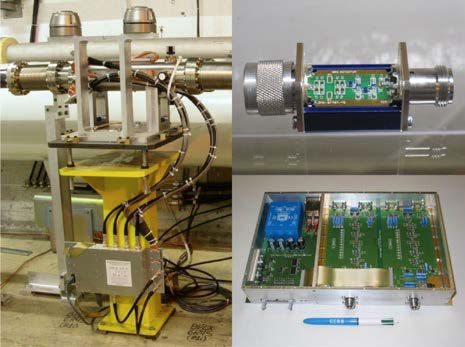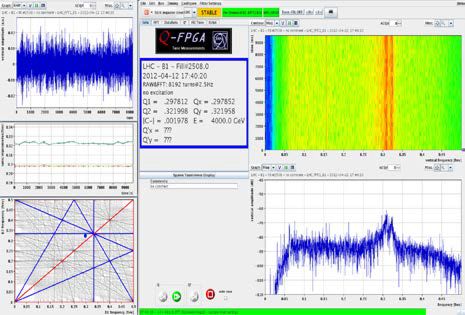If you want to test your imagination further with more sinusoids, try to imagine that what has just been said about the LHC only concerns the horizontal plane and that the particles also oscillate in the vertical direction with a tune of 64.32. To have even more sinusoids, now consider the fact that in a single LHC nominal bunch there are about 100 billion protons (1011), each following its own sinusoid in both horizontal and vertical planes. Since all protons do not have exactly the same energy, in consequence their trajectory sinusoids are also slightly different, as more energetic particles are less deflected by the quadrupoles. The superposition of all 1011 horizontal and vertical sinusoids determines the LHC beam size for one bunch. And now imagine on top of this that there are 1380 bunches colliding in the LHC...
As the accelerator tunes are so important, they have to be measured with high accuracy and maintained on their reference values. At the time of writing the LHC design report this task was considered very difficult, as the standard method to measure the tune required significant external excitation to "synchronise" the motion of individual particles. Otherwise their betatron oscillations appear chaotic to a beam position monitor (BPM), yielding no net signal. The excitation means that the particles follow larger amplitude sinusoids and in consequence, the beam size gets bigger (what is known as emittance growth), lowering the collision rate and increasing the time-to-discovery. For this reason the LHC beams can be excited only up to the micrometre level.
The challenge of measuring the LHC tunes was entrusted to the BE-BI-QP section, where a new technique was developed, allowing the observation of very small beam oscillations. The trick used to achieve an unprecedented sensitivity is to pass the short, high amplitude pulses obtained from a beam position monitor to simple diode detectors; similar to those used in old radio receivers. The detectors convert the tiny modulation of the BPM pulses related to beam oscillations into a convenient signal in the audio frequency range. This can then be nicely processed to deliver the tune content. The dominating part of the BPM signal related to the beam intensity, which typically limits the performance reach in other tune measurement techniques, becomes a DC voltage after the detectors. This is easily blocked using a simple capacitor at the detector outputs. The use of diode detectors brings many new advantages to the tune measurement system, which has resulted in an elegant and relatively simple design sensitive to beam oscillations at the nanometre level. It was a big surprise that with the achieved sensitivity it is possible to see the tiny oscillation of LHC beams present even without excitation. Today the LHC Base-Band Tune measurement system based on diode detectors, known as the BBQ system, is mostly used with natural beam oscillations or with very little additional excitation. This provides the input data for the tune feed-back system, which automatically corrects the strength of the quadrupoles to keep the tunes on their reference values.
As a side effect of the LHC BBQ development, today the LEIR, PSB, PS and SPS accelerators all have similar tune measurement systems based on diode detectors. BBQ systems built at CERN are also in use at 5 other laboratories worldwide.
Another discovery during the BBQ development was that the natural beam oscillations contain more information than just the tunes and they are nice to listen to! A few samples of beam sound from the early BBQ development days as well as more information on the system can be found at www.cern.ch/gasior/pro/bbq/index.html.
This text (and the follwoing figures ) is a web version of an article "Tuning the LHC" published in Issue 4 of BE Newsletter (May 2012).

Fig. 1. LHC BBQ installation and its most important parts: the diode detector and analogue front-end.

Fig. 2. LHC tunes measured in the control room.